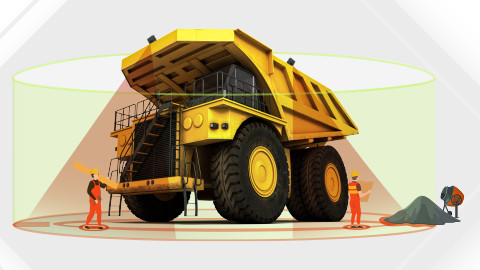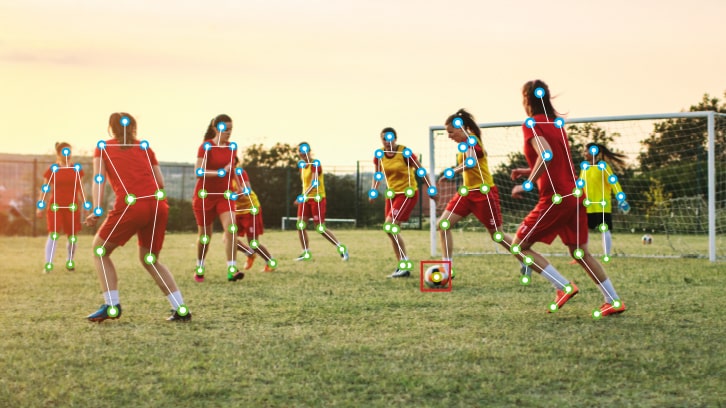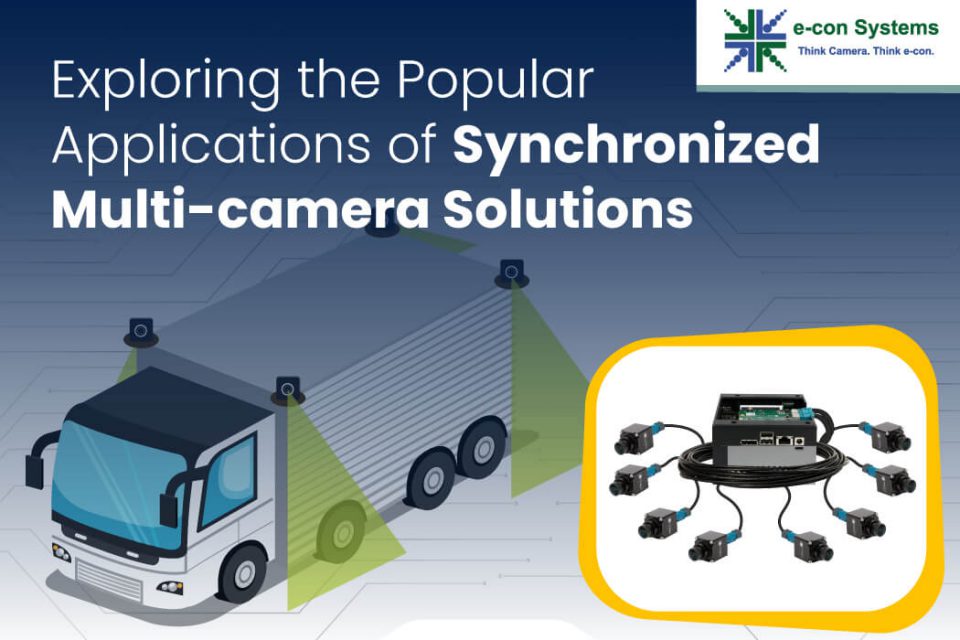Unlocking new dimensions in imaging technology, multi-camera synchronization has revolutionized various industries and applications. From sports broadcasting to autonomous vehicles, the power of synchronized multi-camera setups has had a transformative impact – capturing immersive visuals, enhancing situational awareness, enabling data analysis, and more.
In this blog, we delve into the fascinating world of multi-camera synchronization, exploring its wide-ranging applications and the immense value it brings to different sectors.
What is a multi-camera solution – and how does it work?
A multi-camera solution is a setup incorporating multiple cameras to address specific requirements. Hence, multiple cameras simultaneously capture different angles, perspectives, or aspects of a scene. This synchronization ensures that the cameras capture the same moment, enabling the system to obtain a comprehensive and synchronized view of the scene or subject. However, in some setups, these cameras may not be used to capture images at the same time, which we will explore later in the blog.
Once the images or frames are captured, they can be processed and analyzed collectively to extract valuable insights or perform specific tasks. It can include depth sensing, object tracking, or generating a panoramic view. Using multiple cameras, a multi-camera solution enhances the overall quality, accuracy, and coverage of data acquisition, enabling more robust analysis and decision-making processes. A multi-camera solution’s exact configuration and functionality vary depending on the application.
Crucial questions to ask before multi-camera integration:
- How many cameras will be used?
- What is the synchronization method?
- Which camera interface to use?
- What is the best-fit host platform?
- What is the level of latency?
Popular applications that leverage multi-camera synchronization
Multi-camera solutions find applications in various fields, including:
Surround-View Systems
Surround-view systems rely on multi-camera setups to give drivers a full view of their vehicle’s surroundings. Several cameras are strategically positioned around the vehicle to capture a 360-degree view. These cameras work synchronized to provide a stitched and composite image. This eliminates blind spots – allowing for an accurate representation of the environment.
The data captured by the multi-camera system is processed by advanced algorithms that merge and stitch the images together. This composite image is then displayed, giving the driver a bird’s-eye view and assisting them in maneuvering the vehicle safely. Whether it’s parallel parking, navigating crowded areas, or avoiding obstacles, multi-camera-based surround-view systems lead to increased situational awareness.
 Delivery Robots
Delivery Robots
Multi-camera systems help delivery robots to navigate autonomously and efficiently carry out their tasks. Multiple cameras are synchronized to capture visual data from different angles, enabling the delivery robot to perceive its environment accurately. In turn, the robot can detect and avoid obstacles, identify paths, and make real-time navigation decisions – by leveraging the data captured by the multi-camera system.
Also, the synchronized operation allows the delivery robot to generate a 360-degree view and map its environment to adjust movements as and when required. Integrating multi-camera systems in delivery robots enables them to operate with high autonomy and reliability, revolutionizing the last-mile delivery industry.
Sports Broadcasting Systems
Multi-camera setups have revolutionized the field of sports broadcasting, enabling broadcasters to capture every moment of the game from multiple angles and provide viewers with an immersive viewing experience. Basically, a network of synchronized cameras is positioned throughout the venue to capture different perspectives of the action.
These multi-camera systems allow broadcasters to switch between camera angles seamlessly, showcasing key moments, player reactions, and intricate details of the game. So, they can capture the excitement and intensity of live sporting events, offering viewers a front-row seat to the action – whether a close-up of a game-changing play or a panoramic view of the entire field. Furthermore, these systems also provide critical imaging data that can be used by coaches/players to improve their performance.
 Airport Kiosks
Airport Kiosks
It has become increasingly evident that multiple cameras can be leveraged to capture different biometric data points in airport kiosks. One camera may focus on iris recognition, enabling accurate and reliable identification of individuals. Another camera can be dedicated to facial recognition, ensuring the authentication of passengers by matching their facial features with existing databases. Additionally, a third camera may facilitate document scanning and verification, allowing passengers to scan their travel documents for seamless processing. It’s important to note that while the cameras do not operate with real-time synchronization, they ensure that the kiosks gather comprehensive data to facilitate smooth and secure passenger experiences.
By employing multi-camera systems at airport kiosks, airports can streamline the check-in process, prioritize passenger convenience and safety, and reduce the need for manual intervention.
Multi-camera systems developed by e-con Systems
e-con Systems comes with a wealth of experience when it comes to integrating multi-camera systems. We have successfully implemented numerous multi-camera integrations for clients in various industries, including industrial, retail, smart city, medical, sports, etc.
What sets us apart is our strong partner ecosystem, collaborating with renowned sensor manufacturers like Sony, Onsemi, and Omnivision. As an esteemed partner of NVIDIA, the leading-edge processor provider, we ensure cutting-edge technology for our customers.
We also simplify the camera evaluation process by offering readily available multi-camera solutions that support 2-8 cameras in a single system. Our team provides extensive customization services, tailoring the camera setup to meet your application requirements.
Some of our multi-camera solutions include:
- NileCAM130M_CUQRB5 -13.0 MP Monochrome GMSL2 Camera
- NileCAM210_CUQRB5 – 2.0 MP Ultra-Low Light IMX462 GMSL2 Camera
- NileCAM82_CUQRB5– 8.0 MP Ultra-Low Light IMX485 GMSL2 Camera
- NileCAM81_CUOAGX – AR0821 4K HDR GMSL2 Camera
- e-CAM85_CUQRB5 – Sony® Starvis™ IMX715 Camera
- e-CAM21_CUQRB5 – Full HD HDR Camera
- e-CAM82_CUQRB5 – 4K SONY™ STARVIS™ IMX485 Ultra Low Light camera
- e-CAM130M_CUQRB5 – 13MP AR1335 Monochrome Cameras
- e-CAM210_CUQRB5 – Sony® Starvis™ IMX462 Camera
- e-CAM25_CUQRB5- Global Shutter Camera
- e-CAM180_CUXVR – Six Synchronized 18MP Cameras
- e-CAM130A_CUXVR_3H02R1 Multi-Camera Solution with 180° Image Stitching
- e-CAM27_CUOAGX – 2MP OV2312 Global Shutter RGB-IR Camera
- e-CAM20_CUOAGX – Six Synchronized Global Shutter Camera
- e-CAM81_CUXVR – AR0821 4K HDR Cameras
- e-CAM200_CUOAGX- 20MP AR2020 Four Synchronized Cameras
- e-CAM25_CUXVR – Six Synchronized Global Shutter Cameras
- e-CAM24_CUXVR – 2MP Global Shutter Monochrome Camera
Explore all our synchronized multi-camera solutions.
Visit our Camera Selector page to explore our comprehensive product portfolio. If you need expert assistance integrating a multi-camera system into your applications, please contact us at camerasolutions@e-consystems.com.

Suresh Madhu is the product marketing manager with 16+ years of experience in embedded product design, technical architecture, SOM product design, camera solutions, and product development. He has played an integral part in helping many customers build their products by integrating the right vision technology into them.




